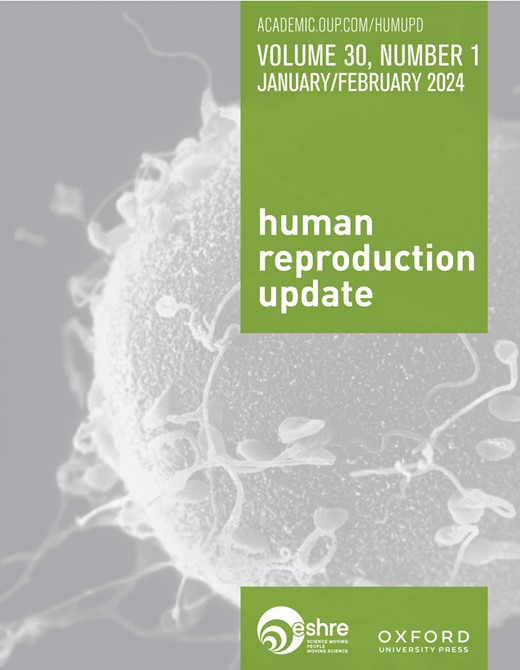The effect of obesity interventions on male fertility: a systematic review and meta-analysis
IF 16.1
1区 医学
Q1 OBSTETRICS & GYNECOLOGY
引用次数: 0
Abstract
Background Obesity is a prevalent modifiable cause of male factor infertility. Preconception guidelines recommend men maintain a healthy weight; however, they provide limited guidance regarding methods or volume of weight loss for men with obesity. First-line interventions for weight loss involve lifestyle optimization (healthy diet and exercise), followed by pharmacotherapy or bariatric surgery in severe cases. Each modality has differing weight loss potential and complications for which the reproductive implications are currently unclear. Objective and Rationale To synthesize the available evidence regarding the reproductive effects of obesity interventions in men with obesity. Where possible, to evaluate whether the observed effects depend on the magnitude of weight loss. Search Methods Searches for articles published in English was performed using PubMed, Web of Science, Embase, Cochrane Central Register of Controlled Trials and Scopus from inception until December 2024, using prespecified keywords pertaining to four categories: male, overweight/obesity, weight loss (bariatric surgery, nutrition, diet, lifestyle, exercise, pharmacotherapy) and fertility (conception, assisted reproduction, sperm, semen). Studies of reproductive-aged men (18–50 years) who underwent an obesity intervention with established weight loss benefits and undertook repeated assessment of reproduction capacity (semen analysis, conception rates, assisted reproduction outcomes) before and after the intervention were included. Meta-analysis was performed when two or more studies of the same modality assessed an outcome measure in a manner suitable for meta-analysis. A meta-regression considering weight loss achieved was performed when five or more suitable studies were available. Narrative review of studies not suitable for meta-analysis occurred. Outcomes 32 studies were included in the analysis, with one study assessing both lifestyle interventions and pharmacotherapy. Assessment of conception rates and assisted reproduction was limited across all modalities. In almost all cases, the effect of obesity interventions on semen quality was examined as a surrogate for reproductive capacity and the certainty of evidence was low. Bariatric surgery was assessed in 18 studies, including 12 quasi-experimental studies, one randomized controlled trial, one case series and four case reports. Fixed- and random-effects meta-analysis of randomized controlled trials identified no differences in sperm parameters between control and intervention arms across any intervention, although small sample size limits interpretability. Random-effects meta-analyses of pre-post outcomes identified no clinically significant semen parameters or DNA damage changes following bariatric surgery. Pharmacotherapy (metformin and liraglutide) was assessed in five studies, including four quasi-experimental studies and one case report. There were insufficient data to draw clear conclusions regarding the impact of these agents on fertility outcomes. Lifestyle interventions were assessed in 10 studies, including five quasi-experimental studies and five randomized controlled trials. Fixed-effect meta-analysis identified improvements in sperm normal morphology (Mean difference = 0.59%, 95% Confidence interval = [0.23, 0.94]), and progressive motility (10.56% [8.97, 12.15]) following a lifestyle intervention. Wider Implications Data regarding weight loss interventions and male fertility is limited primarily to observational studies examining semen quality. Improvements in semen quality following lifestyle interventions suggest a potential benefit of optimizing nutrition and physical activity, whereas a limited change with bariatric surgery indicates obesity-associated sperm dysfunction does not resolve in a dose-dependent manner with weight loss and/or negative effects of rapid weight loss exist. Substantial knowledge gaps were identified, including limited randomized trials, inadequate examination of conception outcomes and limited assessment of GLP-1 agonist effects. Registration Number CRD 42022349665.肥胖干预对男性生育能力的影响:系统回顾和荟萃分析
背景:肥胖是男性因素性不育症的一个普遍的可改变的原因。孕前指南建议男性保持健康的体重;然而,对于男性肥胖患者的减肥方法或减肥量,它们提供的指导有限。减肥的一线干预措施包括生活方式优化(健康饮食和运动),其次是药物治疗或严重情况下的减肥手术。每种方式都有不同的减肥潜力和并发症,其生殖影响目前尚不清楚。目的与理由综合现有的关于肥胖干预对男性肥胖患者生殖影响的证据。在可能的情况下,评估观察到的效果是否取决于体重减轻的程度。检索方法使用PubMed、Web of Science、Embase、Cochrane Central Register of Controlled Trials和Scopus检索从研究开始到2024年12月发表的英文文章,使用与四类相关的预设关键词:男性、超重/肥胖、体重减轻(减肥手术、营养、饮食、生活方式、运动、药物治疗)和生育(受孕、辅助生殖、精子、精液)。研究纳入了在干预前后反复评估生殖能力(精液分析、受孕率、辅助生殖结果)的育龄男性(18-50岁),这些男性接受了肥胖干预,确定了减肥效果。当两项或两项以上相同模态的研究以适合荟萃分析的方式评估结果时,进行荟萃分析。当有五个或更多合适的研究可用时,进行考虑体重减轻的meta回归。出现了不适合meta分析的叙述性综述。32项研究纳入分析,其中一项研究评估了生活方式干预和药物治疗。受孕率和辅助生殖的评估在所有模式中都是有限的。在几乎所有的病例中,肥胖干预对精液质量的影响作为生殖能力的替代指标进行了检查,证据的确定性很低。18项研究对减肥手术进行了评估,包括12项准实验研究、1项随机对照试验、1项病例系列和4项病例报告。随机对照试验的固定效应和随机效应荟萃分析发现,在任何干预中,对照组和干预组之间的精子参数没有差异,尽管小样本量限制了可解释性。对减肥手术前后结果的随机效应荟萃分析发现,在减肥手术后,没有临床显著的精液参数或DNA损伤变化。药物治疗(二甲双胍和利拉鲁肽)在5项研究中进行评估,包括4项准实验研究和1例病例报告。关于这些药物对生育结果的影响,没有足够的数据得出明确的结论。生活方式干预在10项研究中进行评估,包括5项准实验研究和5项随机对照试验。固定效应荟萃分析发现,生活方式干预后,精子正常形态改善(平均差异= 0.59%,95%可信区间=[0.23,0.94]),进步性改善(10.56%[8.97,12.15])。关于减肥干预和男性生育能力的数据主要局限于检查精液质量的观察性研究。生活方式干预后精液质量的改善提示了优化营养和体育活动的潜在益处,而减肥手术的有限变化表明,肥胖相关的精子功能障碍不会以剂量依赖的方式随着体重减轻和/或快速减肥的负面影响而解决。发现了大量的知识空白,包括有限的随机试验,对受孕结果的检查不足和对GLP-1激动剂作用的评估有限。注册号CRD 42022349665。
本文章由计算机程序翻译,如有差异,请以英文原文为准。
求助全文
约1分钟内获得全文
求助全文
来源期刊

Human Reproduction Update
医学-妇产科学
CiteScore
28.80
自引率
1.50%
发文量
38
期刊介绍:
Human Reproduction Update is the leading journal in its field, boasting a Journal Impact FactorTM of 13.3 and ranked first in Obstetrics & Gynecology and Reproductive Biology (Source: Journal Citation ReportsTM from Clarivate, 2023). It specializes in publishing comprehensive and systematic review articles covering various aspects of human reproductive physiology and medicine.
The journal prioritizes basic, transitional, and clinical topics related to reproduction, encompassing areas such as andrology, embryology, infertility, gynaecology, pregnancy, reproductive endocrinology, reproductive epidemiology, reproductive genetics, reproductive immunology, and reproductive oncology. Human Reproduction Update is published on behalf of the European Society of Human Reproduction and Embryology (ESHRE), maintaining the highest scientific and editorial standards.
 求助内容:
求助内容: 应助结果提醒方式:
应助结果提醒方式:


